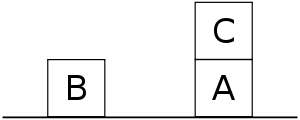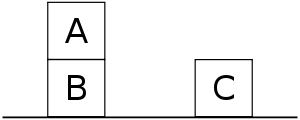Sussman Anomaly
The Sussman Anomaly is a problem in artificial intelligence, first described by Gerald Sussman, that illustrates a weakness of noninterleaved planning algorithms, which were prominent in the early 1970s. In the problem, three blocks (labeled A, B, and C) rest on a table. The agent must stack the blocks such that A is atop B, which in turn is atop C. However, it may only move one block at a time. The problem starts with B on the table, C atop A, and A on the table:

However, noninterleaved planners typically separate the goal (stack A atop B atop C) into subgoals, such as:
- get A atop B
- get B atop C
Suppose the planner starts by pursuing Goal 1. The straightforward solution is to move C out of the way, then move A atop B. But while this sequence accomplishes Goal 1, the agent cannot now pursue Goal 2 without undoing Goal 1, since both A and B must be moved atop C:

If instead the planner starts with Goal 2, the most efficient solution is to move B. But again, the planner cannot pursue Goal 1 without undoing Goal 2:

The problem was first identified by Sussman as a part of his PhD research. Sussman (and his supervisor, Marvin Minsky) believed that intelligence requires a list of exceptions or tricks, and developed a modular planning system for "debugging" plans. Most modern planning systems can handle this anomaly, but it is still useful for explaining why planning is non-trivial.
See also
- STRIPS
- Automated planning
- Greedy algorithm
Sources
- Russell, Stuart J.; Norvig, Peter (2003), Artificial Intelligence: A Modern Approach (2nd ed.), Upper Saddle River, New Jersey: Prentice Hall, p. 414, ISBN 0-13-790395-2
- G.J. Sussman (1975) A Computer Model of Skill Acquisition Elsevier Science Inc. New York, NY, USA. Book version of his PhD thesis.